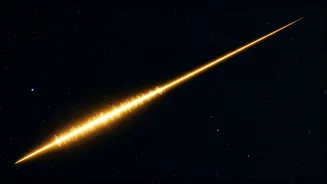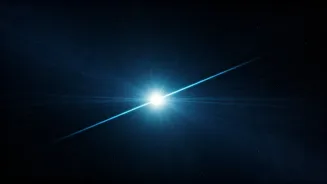The Viral Claim
The central assertion revolves around a purported signal detected from the 3I/ATLAS comet. This signal is alleged to have exhibited a pattern consistent
with the Fibonacci sequence: 8 • 13 • 8 • 5 • 13 • 8 pulses at a frequency of 1420 MHz. This claim has gained traction online, prompting speculation about potential extraterrestrial intelligence. The specificity of the signal, aligning with the Fibonacci sequence, has captured the imagination of many. The timing and the origin of the signal from a comet further add to the mystery, sparking discussions in scientific and non-scientific communities. The viral nature of the claim underscores the public's inherent fascination with the possibility of discovering life beyond Earth, fueling the ongoing debate and encouraging deeper examination of the evidence provided.
Fibonacci Sequence Explained
The Fibonacci sequence is a mathematical series where each number is the sum of the two preceding ones, typically starting with 0 and 1. The sequence unfolds as follows: 0, 1, 1, 2, 3, 5, 8, 13, 21, and so forth. This sequence appears frequently in nature, from the arrangement of petals on a flower to the spiral patterns in seashells. Its presence in natural phenomena has led to its mystique and its use in various fields, including art, architecture, and now, potentially, in the search for extraterrestrial communication. The inherent order and mathematical elegance of the Fibonacci sequence make it a compelling subject of study, and its possible use by intelligent life represents an exciting area of exploration.
Analyzing the Signal
The claim of a Fibonacci-like signal from 3I/ATLAS requires careful scrutiny. The specific pulse sequence – 8 • 13 • 8 • 5 • 13 • 8 – is central to the argument. Researchers must analyze the signal's origin, verifying it comes from the comet and is not a product of terrestrial interference or instrumental error. Confirmation would include independent observations by multiple observatories to ensure the signal's authenticity. The analysis would examine the signal's frequency and the modulation to exclude the possibility of natural phenomena, noise, or known communication patterns. Only through rigorous examination can the scientific community assess the claim's validity.
1420 MHz: Significance?
The frequency of 1420 MHz plays a crucial role in this claim. This frequency is particularly significant as it corresponds to the natural emission of hydrogen, which is the most abundant element in the universe. This makes 1420 MHz a well-known 'waterhole' frequency that SETI researchers have actively targeted in the search for extraterrestrial intelligence. If the signal was detected at this frequency, it could be interpreted as a deliberate attempt to communicate by extraterrestrial beings, assuming the signal's intentionality and alien origin are confirmed. The focus on this frequency adds weight to the potential implications of the signal, intensifying the need for careful study and verification.
Implications and Speculation
If confirmed, the detection of a Fibonacci-like signal would have profound implications. It could suggest that intelligent extraterrestrial life exists and is attempting to communicate with Earth. The use of the Fibonacci sequence could imply a universal understanding of mathematics across the cosmos. Furthermore, such a discovery could shift humanity's perspective, influencing scientific exploration, philosophy, and societal beliefs about its place in the universe. The mere possibility encourages discussions about the ethics and procedures required to respond to such a signal, highlighting the gravity and potential consequences of uncovering alien intelligence.
Skepticism and Counterarguments
Despite the excitement, skepticism remains essential. Critics argue that the Fibonacci-like pattern could be a coincidence, or the product of natural processes that mimic the sequence. The absence of corroborating evidence and the challenges in verifying such a distant signal contribute to the skepticism. Researchers also highlight the potential for data analysis bias, where patterns are perceived where they don't exist. Thorough investigation and independent validation are critical to distinguish authentic signals from statistical flukes or natural phenomena. Such scrutiny ensures responsible interpretation, guarding against premature claims and promoting scientific rigor.














